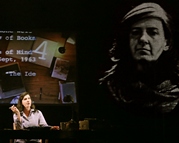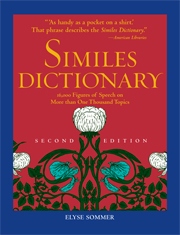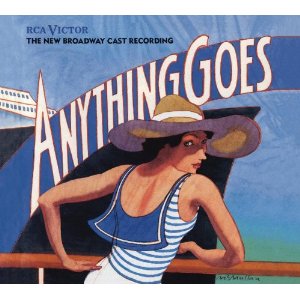SITE GUIDE
SEARCH
REVIEWS
REVIEW ARCHIVES
ADVERTISING AT CURTAINUP
FEATURES
NEWS
Etcetera and
Short Term Listings
LISTINGS
Broadway
Off-Broadway
NYC Restaurants
BOOKS and CDs
OTHER PLACES
Berkshires
London
California
New Jersey
DC
Philadelphia
Elsewhere
QUOTES
TKTS
PLAYWRIGHTS' ALBUMS
LETTERS TO EDITOR
FILM
LINKS
MISCELLANEOUS
Free Updates
Masthead
A CurtainUp Review
Sontag: Reborn
| "
In NY sensuality completely turns into sexuality--no objects for the senses to respond to, no beautiful river, houses, people. Awful smells on the street, and dirt...Nothing except eating, if that, and the frenzy of the bed. "— Sontag
|

|
At the end of the seventy-five minute dramatic discourse in which Moe Angelos portrays the American author, political activist, literary icon and sexual adventurer in the flesh as well as on screens of various sizes, she says: "I write to define myself — an act of self-revelation — part of the process of becoming — In dialogue with myself, with writers I admire living and dead, with ideal readers. . .Because it gives me pleasure..."
The play, which didn't give me much pleasure, covers Sontag's years between 1948 and 1964. The audience at the New York Theatre Workshop is obliged to either listen attentively and/or be transfixed by the words (as the case may be) of this renowned intellectual, philosopher, impassioned lesbian, and theorist whose Notes on Camp propelled her into prominence in the mid 1960s. Sontag's clipped, flippant opining about her sexual appetite, failed marriage to a college professor, various movies and books she likes or dislikes, her club-hopping in gay Paree and the even gayer San Francisco, is, of course, self-serving but also self-validating, particularly when it came to her homosexuality.
There is a lot of breast-beating with regard to her lengthy affair with playwright Maria Irene Fornes. What little humor there is involves a curious visit to the home of Thomas Mann where she conspires to keep a lit cigarette from burning out so she can keep it as a memento.
Not having any preconceived ideas regarding Sontag's literary prominence, either as a novelist, theorist, essayist et al, or more specifically the mystique that presumably surrounded her, this presentation affected me as a rather presumptuous assumption that her journal jottings have the stuff/heft of dramatic literature.
The video design and imagery created by Austin Switser for The Builders Association (a group founded in 1994 that has become known for blending live performance, text and architecture to tell stories) turns what would, despite its source, otherwise be deadly exposition and dreary commentary into a moderately lively and imaginative experience.
The only architecture is the desk and chair on which the young Sontag sits and makes her journal entries. Various sized screens and one very large screen that is the width of the stage are used effectively to document the people and places that the text visits. Angelos handles the chore of being the writer as well as the imposing chain-smoking filmed image of Sontag as a hovering ghost and as a commenting collaborator. In one sense, however, director Marianne Weems, has done a brilliant job of making this pretentious homage a visual treat. I don't know how it is done, but video and film appear to be used jointly to create a stunning 3D effect during the play's final moments.
Angelos gives a convincing portrait of a glib, opinionated Sontag. It is amusing to see her every movement, scribbling with a pen, tapping at the keys of a typewriter captured on an overhead camera. I don't know how or if Sontag: Reborn, as adapted for the stage by Angelos based on the Rieff's published book: Reborn: Journals and Notebooks, 1947 - 1963, has been altered or changed since it was first done last year in the Under the Radar Festival at the Public Theater. But at the New York Theater Workshop, everything that could be done has been done by the technical team to make it more than what meets the ear.
It quickly becomes apparent that Sontag's savory, by-metaphor-graced ("Our marriage is a sequence of alternating self-immolations") vocabulary welcomes the enhancement of performance art, as did her leap from the page to the stage with Alice in Bed given a heightened sense of abstracted surrealism by director Ivo van Hove at the New York Theatre Workshop in 2000.
Editor's Note: This piece was first presented at The 2012 Under the Radar Festival at the Public Theater where it was reviewed by Deirdre Donovan. While Deirdre posited that it was a tricky business to dramatize writing or writers on the stage. She saw why to many reading Sontag’s actual journals would be more satisfying (and certainly cheaper!) than seeing this theatrical adaptation. However, she countered this with "frankly, part of the appeal of Sontag: Reborn is that somebody else has already taken the time to read through her journals, digested them, and now enables you to enjoy them in a more expressive form."
|
Sontag: Reborn Adapted and Performed by Moe Angelos Created by The Builders Association Directed by Marianne Weems Video Design: Austin Switser Sound Design: Dan Dobson Lighting Design: Laura Mcoczkowski Scenic Design: Joshua Higgason Costume Design: Andreea Mincic Running time: 1 hour 15 minutes New York Theatre Workshop, 79 E. 4th Street (212) 279 - 4200 Tickets: $65.00 Performances: Sunday, Tuesday, Wednesday at 7pm; Thursday, Friday, Saturday at 8pm; Matinees Saturday at 3pm and Sunday at 2 pm. From 05/28/13 Opened 06/06/13 Ends 06/30/13 Review by Simon Saltzman based on performance 06/04/13 |
| REVIEW FEEDBACK Highlight one of the responses below and click "copy" or"CTRL+C"
Paste the highlighted text into the subject line (CTRL+ V): Feel free to add detailed comments in the body of the email. . .also the names and emails of any friends to whom you'd like us to forward a copy of this review. Visit Curtainup's Blog Annex For a feed to reviews and features as they are posted add http://curtainupnewlinks.blogspot.com to your reader Curtainup at Facebook . . . Curtainup at Twitter Subscribe to our FREE email updates: E-mail: esommer@curtainup.comesommer@curtainup.com put SUBSCRIBE CURTAINUP EMAIL UPDATE in the subject line and your full name and email address in the body of the message. If you can spare a minute, tell us how you came to CurtainUp and from what part of the country. |



 Anything Goes Cast Recording
Anything Goes Cast Recording Book of Mormon -CD
Book of Mormon -CD